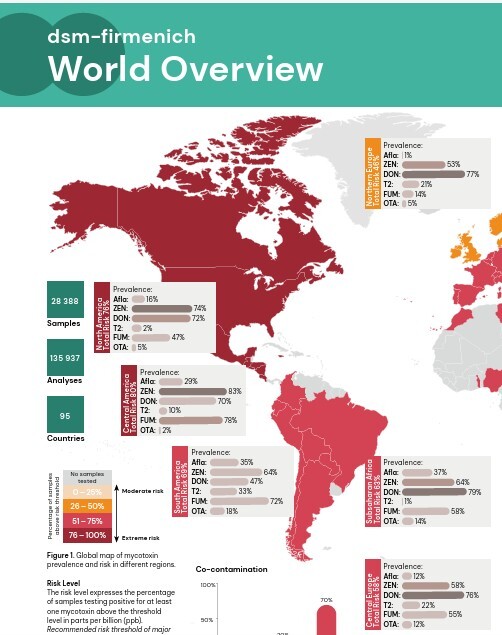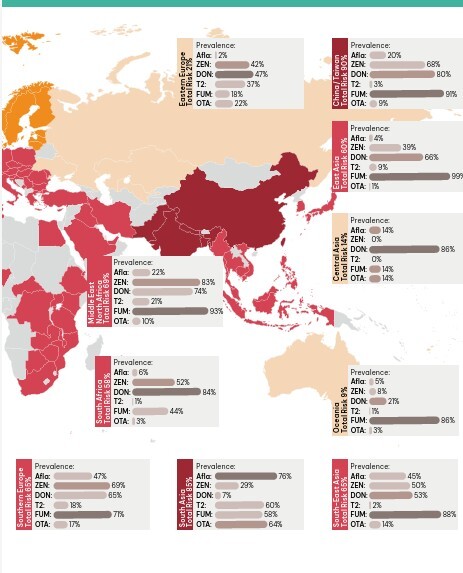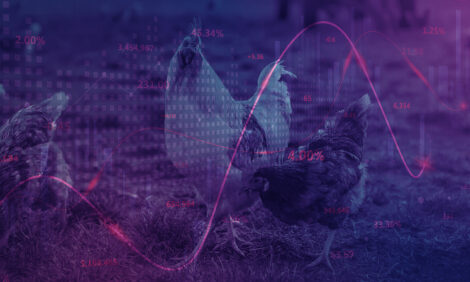



IPPE: dsm-firmenich's 2024 Global Mycotoxin Survey shows high co-occurrence of mycotoxins
More than 75% of samples have more than one mycotoxin present, so consider your mitigation strategiesDr. Chasity Pender, a poultry technical manager with dsm-firmenich, spoke to The Poultry Site’s Sarah Mikesell at International Processing and Production Expo (IPPE) in Atlanta, Georgia, USA, about dsm’s long-running Global Mycotoxin Survey just released for 2024.
dsm-firmenich has run its mycotoxin survey for two decades. Tell us what you learned from the 2024 crop.
This is the longest-running, most comprehensive mycotoxin survey out there. We've been doing it since 2004. For this survey, we get samples from all over the country, including the entire U.S. and Canada, and we analyze those samples using LC-MSMS technology. Then we put them in our survey. We look at occurrence levels, co-occurrence trends, various levels of contamination, and we compare those to previous years and what we've seen.
This year, what we've been seeing so far, but it's still early in the season, but in terms of occurrence, we're seeing fumonisins and type B trichothecenes, predominantly deoxynivalenols (DON) which are taking the lead with fumonisins coming in third place. But if you look at their contamination levels, fumonosin seems to be holding steady, and B-trichothecenes and zearalenones seem to be taking a small dip so far this year. But again, we're early in the season. So, we'll kind of see how that plays out as we get more samples in.
What are some of the key takeaways from the report?
In terms of key takeaways, I would say co-occurrence is really the rule of thumb that producers need to know. Every year we see co-occurrence levels. That's where more than one mycotoxin is present at the same time. More than 75% of the time our samples come in with more than one mycotoxin present. When you're looking at mitigation strategies, you need to look at a strategy that encompasses a wider scope of mycotoxins. You can't just look at one mycotoxin. You need to look at a broader scope.
My family farms in central Ohio and we had a really dry July and August in 2024. How does weather play a role?
Weather plays a significant role and you're right this year Ohio is usually wet. The Midwest tends to be on the dry side if not in a drought but this year we saw a complete reversal where there was a drought in Ohio. The Midwest had much higher levels of rainfall.
Weather is a strong player when it comes to which molds are growing and then which mycotoxins they're going to be producing. It's really a lot more complicated than that. We have found there's weather, but also when did that weather happen? Was it during the silking stage? Was it during harvest? How long were those plants in the field? Were they harvested early in the season? Were they harvested late in the season? What was the insect pressure that plays a role that can make the plants more susceptible to mold growth? Were there any weather events that happened like a windstorm that came through? There's a multitude of factors that play a role. The straightforward way to answer it is that it's difficult.
How often should producers be testing to know what's happening in their feed and in their feed components?
I like to use our survey as a baseline. It gives you some data of what we're seeing across different states and provinces. But really, knowledge is power. The more data you can get, especially with the ingredients and the feed that you are feeding to your birds, to me that's the most valuable data. The more data you can get, the better that is really what I can say. Monitoring what you're seeing, what your birds are seeing is to me that that's the most important.










